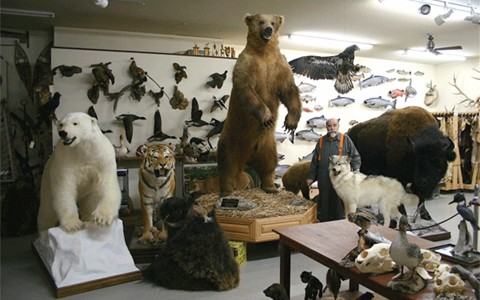
Nearly a year ago, we marveled at the way in which ancient physicians used ant jaws as sutures. Blame our childhood Flintstones habit, but we have a soft spot for techniques that require the assistance of live animals. And so imagine our glee upon discovering the role that dermestid beetles play in the twin disciplines of taxidermy and fossil cleaning.
We should probably take a step back for a moment and recount how we stumbled upon this wondrous scrap of knowledge. It came up during our perusal of an indispensable (and slightly gross) guide to distinguishing between real and fake tiger penises. Due to the heavy illegal trade in tiger genitalia, some unfortunate employees of the U.S. Fish and Wildlife Service must regularly analyze seized products that purport to be feline penises. As it turns out, the vast majority of these products are fakes—the members of horses or deer gussied up to appear as if they were taken from tigers. The guide’s advice to rookies assigned to this discernment task essentially boils down to this:
The penis from a real tiger has a small triangular baculum, but it is seldom visible even in an x-ray, being obscured by folds in dense, dried tissues. The genitalia of other mammals are used in the wildlife trade, and can usually be identified by the size and shape of the internal penis bone or baculum. Sometimes the dried genitals must be macerated or cleaned by dermestid beetles to extract the baculum. X-rays are the best screening tool for initial examination of the dried penis. An expert should be consulted to interpret the radiographs.
How could we resist the image of humble beetles being called in to do a job that mankind’s most advanced chemicals cannot? In fact, the work of the beetles must be vastly superior to whatever super-bleaches can accomplish; otherwise, it’s hard to imagine any taxidermist going through the trouble of maintaining a beetle colony.
Dermestid beetles are also frequently used in forensic entomology, in order to date human remains. And they’ve apparently been at their bone-cleaning work for many millennia, given that their bites have been discovered on dinosaurs. If you have the stomach for it, click here to see the critters at work. Readers of a more sensitive constitution, please go here instead.
(Image via Gander’s Taxidermy)


Jordan // Feb 26, 2010 at 11:04 am
Hey, if maggots can clean out wounds better than humans, I can certainly imagine beetles cleaning off bones better than we can.
Brendan I. Koerner // Feb 26, 2010 at 11:05 am
Good point. Wonder if anyone’s looking at the specific mechanism of action here, and how we might reproduce it in an artificial way. Maintaining these creatures seems like far more of a hassle than simply using liquid from a bottle.
scottstev // Feb 26, 2010 at 12:27 pm
Actually Jordan, a recent study I ready about (abstract) stated that maggots were no better or worse than other methods of debridement, but may be preferable in some cases. Still that’s an excellent record for mother nature.
hubcap // Mar 1, 2010 at 1:51 pm
Way back in high school I did a brief unpaid internship at the Smithsonian. Now I would find it more interesting, but as a teenager it bored me to tears. But the highlight was definitely the beetle room, used to prepare specimens for display and examination.
Fun as it is, when beetles eating stuff is the high point…well, that made me realize I did not have the patience for big-time biology. Another dream shattered.
Brendan I. Koerner // Mar 1, 2010 at 3:12 pm
They have a whole beetle room? You have no idea how much I’d like to see that.
I’m actually toying with the idea of finding a new career, so maybe tending to the Smithsonian’s dermestids is the right path for me. I’m good at coping with boredom, as long as I can listen to my music.
hubcap // Mar 1, 2010 at 4:11 pm
Well, it’s a room full of fish tanks with beetles in them. Smells like chemicals and mealworms IIRC (and I almost certainly don’t)
And they can skeletonize a cow in!
In!
Um, 10 or 12 days?
Jordan // Mar 2, 2010 at 3:53 pm
Music or other material is the key to dealing with monotonous tasks. One of the reasons I love lab work is that it gives me a lot of time doing things with my hands when I can also listen to music, podcasts or audiobooks.
Brendan I. Koerner // Mar 2, 2010 at 3:57 pm
@Jordan: Conversely, one of the things I dislike about writing is the fact I can’t listen to music while I do it. Certainly nothing with words, at least–I tend to focus on the lyrics too much, which takes away from my ability to create my own coherent sentences. I occasionally pipe a little jazz into my headphones while writing, but usually only when I’m working on a later draft. The first draft is usually done in silence.
That said, I do like to take breaks to listen to a song that gets the creative juices flowing. Just 30 minutes ago, I stepped outside and cranked Nas’s “Halftime” at maximum volume. Very helpful.